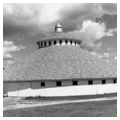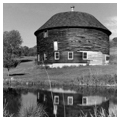As Wisconsin’s farmers made the transition from wheat farming to dairying at the turn of the twentieth century, many of them constructed polygonal and round barns. The large number of these barns reflects the widespread influence of Franklin H. King, a leading professor of agricultural physics at the Wisconsin Agricultural Experiment Station in Madison.
King published his research on round silos and barns in the station’s bulletins, and his plans were reprinted in books and farm journals throughout the nation. According to King, a circular barn required less material to build than other shapes, offered greater structural stability for its curved walls, withstood strong winds better, and provided more space for storage, because the walls supported the roof, making interior supports unnecessary. A central silo allowed for a single feeding trough, and the circular aisle proved more efficient for dairying because farmers could move from one cow to the next without retracing their steps. King also found that wedge-shaped stalls suited cows’ bodies well and provided ample room for milking.
Typically round barns were built of wood with horizontal siding and were covered with a double-pitched conical roof. A cupola at the center of the roof provided light and ventilation. Windows pierced in the basement walls reflected the belief that sunlight promoted healthy cows and a germ-free environment.
Round and polygonal barns were built of concrete, metal, brick, ceramic tile, and cordwood, but the vast majority were of wood. Only one Wisconsin example of a barn made entirely of stone is known today. It was built by Matthew Annala IR4 in Iron County of multicolored field-stone. Inside, the central silo is also of fieldstone. Among Wisconsin’s several builders who became known for their skill in constructing wooden barns were German American Ernst Clausing, who built at least eight octagonal barns OZ7 in Ozaukee County, and African American farmer and carpenter Alga Shivers, who built fifteen round barns in Vernon County VE1.
Changes in agricultural economics and technology brought a decline in the construction of round barns. They did not readily accommodate additions to expanding dairy herds or adapt to greater mechanization. Farmers found the central silos difficult to fill, and the circular fittings were expensive to install and maintain. After 1916 the state agricultural extension service ceased recommending round barns. Nevertheless, the fact that a round barn was highlighted at the Marquette County fair see MQ2 as late as 1921 suggests that many farmers continued to see the round barn as a useful concept.
Writing Credits
If SAH Archipedia has been useful to you, please consider supporting it.
SAH Archipedia tells the story of the United States through its buildings, landscapes, and cities. This freely available resource empowers the public with authoritative knowledge that deepens their understanding and appreciation of the built environment. But the Society of Architectural Historians, which created SAH Archipedia with University of Virginia Press, needs your support to maintain the high-caliber research, writing, photography, cartography, editing, design, and programming that make SAH Archipedia a trusted online resource available to all who value the history of place, heritage tourism, and learning.



